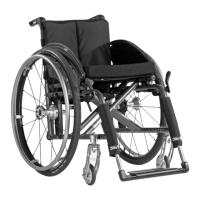80
6.1 Adjusting the Wheel Lock (Fig. 57)
To change the position of the rear wheels, rst loosen the wheel lock attachment screws and
push the wheel lock forward. Then reposition the rear wheels. The wheel lock should then be
remounted such that the distance between the tyres and brake block is when the
wheel lock is not activated (Fig. 57; subject to technical changes).
The wheel locks are only effective with sufcient air pressure and proper adjustment.
The proper air pressure is indicated on the side wall of the tyre, but should at least be
(350 kPa). To ensure sufcient braking effect, use only original rear wheels with an approved
radial excursion of maximally .
Make sure to rmly retighten all screws and nuts after making adjustments! The torque
for the attachment screws of the wheel lock is .
57
0,5 cm
6.2 Changing the Rear Wheel Adapter Position in the Frame (Fig. 58)
The further back the rear wheel is attached, the longer the wheelbase and the greater the wheel-
chair stability (refer to section 5.14 "Wheelbase Extension").
Attaching the rear wheels in a more forward position (only for advanced wheelchair users!)
reduces the load on the casters, which makes the wheelchair more manoeuvrable. The caster
wheels can then also be lifted more easily to clear obstacles such as curbs or steps.
To adjust the horizontal position of the rear wheel, rst remove the countersunk head screws
(Fig. 58, item A). Choose the desired position (Fig. 58, item B) and re-assemble the screws.
Ensure that the left and right rear wheel adapters have the same horizontal position in the
frame.
Please note: If the rear wheels are in a more forward position and the
user's body is not appropriately positioned, the user may tip backward – even on level ground!
For untrained wheelchair users and when there are extreme adjust-
ments to the rear wheel, an anti-tipper is strongly recommended!
For transfemoral amputees it is essential to shift the rear wheels back-
wards!

